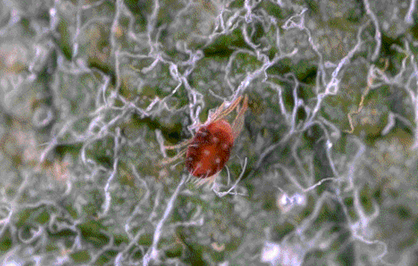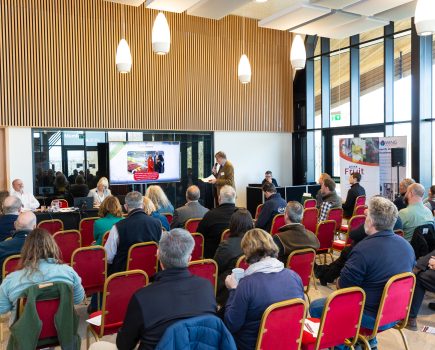A novel optimised and patented primer formulation has been developed by Panagaea Biosciences and has been tested with resistant acaricides for the control of red spider mite, a major pest in the UK. The main use of Booster™ is in situations with resistance problems and restoring efficacy to acaricides and insecticides suffering from significant field resistance.
Booster™ is a patented product which works by inhibiting or neutralising a pest’s defensive enzyme before the pesticide is applied. The primer leaves the pest in a hypersensitive state so that the concentration of the pesticide will kill even the most resistant types. It does this by deactivating the metabolic pathway (Cytochrome P450) in insects, which cause breakdown of the insecticide. This is achieved through precision application of Booster™ and the pesticide by a time delay. “Temporal synergy” is a patented process whereby old chemistry can be rejuvenated and resistance reduced.
Fruit tree red spider mites are sap feeding pests of fruit trees (apple, pear, cherry and plums). They emerge from cracks and crevices in the bark start in March, feeding on leaves and laying eggs. Glasshouse red spider mite or the two-spotted spider mite (Tetranychus urtica) are a problem on many protected crops, causing damage to plants through their feeding. They thrive in warm and dry conditions which is why they are commonly found in most greenhouses crops, including peppers, cucumbers, melons, aubergines, tomatoes, strawberries and ornamentals. For both species, the symptoms are discolouration, speckling or mottling of leaves upper surfaces caused by feeding on sap and this can lead to plant death in worse cases. When the infestation is advanced, you can see fine webbing on new plant growth. Red spider mites are generally active from March to October when the conditions are suitable for breeding. Severe damage can occur under warm dry conditions.
Red spider mites are probably the smallest common sap-feeding pests, less than 1mm in size, usually seen on the undersides of leaves. You need a magnifying glass to identify them. They have 8 legs, no antennae and an oval body with two dark patches. Red spider mites aren’t red at all. They are yellowish-green but turn red in the autumn and winter resting period. Spider Mites are difficult to control as they readily develop tolerance to chemical control and require several applications of chemicals to control all the stages of the life cycle. This becomes more of a problem to edible crops as restrictions apply to the number of applications that can be made and approved chemical usage.
Booster™ has been tested with with 3rd generation mectin and abermectin, neither of which were controlling mites but when tank mixed with Booster™ efficacy was improved by overcoming resistance of the insecticide. The first commercial use and registration for Booster was to control pollen beetle (Meligethes aeneus) in oilseed rape. This is a key insect species across Europe with high resistance to pyrethroids (more than 60% resistance across Europe) in the field. In some countries such as Poland and Lithuania resistance is as high as 80%. This pest is a major threat to the profitability of oilseed rape. Booster™ restores efficacy to pyrethroids such as cypermethrin and lamda-cyalothrin. It works on the cytochrome P450 pathway and so making the pollen beetle much more sensitive to the pyrethroid once again.
“This is exciting when we consider the impact of resistance across Europe and the world,” says Nick Gooch who heads up Pangaea Biosciences. “In the UK we are also working on the use of Booster™ with pyrethroids for the control of Cabbage Stem Flea Beetle (Psylliodes chrysocephala), a major threat in oilseed rape in the UK and one that has often resulted in the inability to grow this crop. We are working on other beetles such as the Asian stink bug, caterpillar species such as diamond back moth and cotton bollworm and plant sucking insects such as whitefly, planthoppers as well as red spider mite.”
Booster™ was identified at Rothamsted Research Station in 1950’s as a substance which deactivated or blocked normal metabolic pathways (Cytochrome P450) of pesticide breakdown. Its great strength is that it rejuvenates older chemistry and can negate the need for high cost and time (£250 million and 10 to 12 years) in developing a new chemical. Pangaea Biosciences has optimised the formulation of Booster™, improving its stability and uptake, chemical compatibility and resulting in superior efficacy in extensive field trials. The product increases the effectiveness of a pesticide and rejuvenates products with resistance issues. “We recognise that resistance is now a major issue in agriculture and a significant threat to global food security, whereas this wasn’t the case in previous decades,” says Nick. “The ability to bring back a range of chemistries which have all but reached their market maximum through resistance problems should have enormous appeal to farmers.”
FarmSaver is the trading arm supplying Booster™ onto farm within the UK and the EU.







